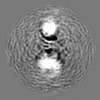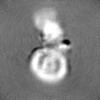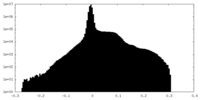+ Open data
Open data
- Basic information
Basic information
| Entry |  | |||||||||||||||
|---|---|---|---|---|---|---|---|---|---|---|---|---|---|---|---|---|
| Title | carvedilol-B1AR-arrestin2-V2Rpp complex | |||||||||||||||
 Map data Map data | ||||||||||||||||
 Sample Sample |
| |||||||||||||||
 Keywords Keywords | G protein-coupled receptor / B1-adrenergic receptor / carvedilol / arrestin2 / biased agonism. / MEMBRANE PROTEIN | |||||||||||||||
| Biological species |  Homo sapiens (human) / Homo sapiens (human) /  | |||||||||||||||
| Method | single particle reconstruction / cryo EM / Resolution: 6.5 Å | |||||||||||||||
 Authors Authors | Tatli M / Abiko LA / Petrovic I / Stahlberg H / Grzesiek S | |||||||||||||||
| Funding support |  Switzerland, 4 items Switzerland, 4 items
| |||||||||||||||
 Citation Citation |  Journal: Proc Natl Acad Sci U S A / Year: 2025 Journal: Proc Natl Acad Sci U S A / Year: 2025Title: Arrestin recognizes GPCRs independently of the receptor state. Authors: Ivana Petrovic / Meltem Tatli / Samit Desai / Anne Grahl / Dongchun Ni / Henning Stahlberg / Anne Spang / Stephan Grzesiek / Layara Akemi Abiko /  Abstract: Only two nonvisual arrestins recognize many hundreds of different, intracellularly phosphorylated G protein-coupled receptors (GPCRs). Due to the highly dynamic nature of GPCR•arrestin complexes, ...Only two nonvisual arrestins recognize many hundreds of different, intracellularly phosphorylated G protein-coupled receptors (GPCRs). Due to the highly dynamic nature of GPCR•arrestin complexes, the critical determinants of GPCR-arrestin recognition have remained largely unclear. We show here that arrestin2 recruitment to the β-adrenergic receptor (βAR) can be induced by an arrestin-activating phosphopeptide that is not covalently linked to the receptor and that the recruitment is independent of the presence and type of the orthosteric receptor ligand. Apparently, the arrestin-receptor interaction is driven by the conformational switch within arrestin induced by the phosphopeptide, whereas the electrostatic attraction toward the receptor phosphosites may only play an auxiliary role. Extensive NMR observations show that in contrast to previous static GPCR•arrestin complex structures, the βAR complex with the beta-blocker carvedilol and arrestin2 is in a G protein-inactive conformation. The insensitivity to the specific receptor conformation provides a rationale for arrestin's promiscuous recognition of GPCRs and explains the arrestin-biased agonism of carvedilol, which largely blocks G protein binding, while still enabling arrestin engagement. | |||||||||||||||
| History |
|
- Structure visualization
Structure visualization
| Supplemental images |
|---|
- Downloads & links
Downloads & links
-EMDB archive
| Map data |  emd_50623.map.gz emd_50623.map.gz | 96.7 MB |  EMDB map data format EMDB map data format | |
|---|---|---|---|---|
| Header (meta data) |  emd-50623-v30.xml emd-50623-v30.xml emd-50623.xml emd-50623.xml | 18.7 KB 18.7 KB | Display Display |  EMDB header EMDB header |
| FSC (resolution estimation) |  emd_50623_fsc.xml emd_50623_fsc.xml | 10 KB | Display |  FSC data file FSC data file |
| Images |  emd_50623.png emd_50623.png | 66.9 KB | ||
| Masks |  emd_50623_msk_1.map emd_50623_msk_1.map | 103 MB |  Mask map Mask map | |
| Filedesc metadata |  emd-50623.cif.gz emd-50623.cif.gz | 4.5 KB | ||
| Others |  emd_50623_additional_1.map.gz emd_50623_additional_1.map.gz emd_50623_half_map_1.map.gz emd_50623_half_map_1.map.gz emd_50623_half_map_2.map.gz emd_50623_half_map_2.map.gz | 49.1 MB 95.3 MB 95.3 MB | ||
| Archive directory |  http://ftp.pdbj.org/pub/emdb/structures/EMD-50623 http://ftp.pdbj.org/pub/emdb/structures/EMD-50623 ftp://ftp.pdbj.org/pub/emdb/structures/EMD-50623 ftp://ftp.pdbj.org/pub/emdb/structures/EMD-50623 | HTTPS FTP |
-Validation report
| Summary document |  emd_50623_validation.pdf.gz emd_50623_validation.pdf.gz | 748 KB | Display |  EMDB validaton report EMDB validaton report |
|---|---|---|---|---|
| Full document |  emd_50623_full_validation.pdf.gz emd_50623_full_validation.pdf.gz | 747.5 KB | Display | |
| Data in XML |  emd_50623_validation.xml.gz emd_50623_validation.xml.gz | 18.3 KB | Display | |
| Data in CIF |  emd_50623_validation.cif.gz emd_50623_validation.cif.gz | 23.5 KB | Display | |
| Arichive directory |  https://ftp.pdbj.org/pub/emdb/validation_reports/EMD-50623 https://ftp.pdbj.org/pub/emdb/validation_reports/EMD-50623 ftp://ftp.pdbj.org/pub/emdb/validation_reports/EMD-50623 ftp://ftp.pdbj.org/pub/emdb/validation_reports/EMD-50623 | HTTPS FTP |
- Links
Links
| EMDB pages |  EMDB (EBI/PDBe) / EMDB (EBI/PDBe) /  EMDataResource EMDataResource |
|---|
- Map
Map
| File |  Download / File: emd_50623.map.gz / Format: CCP4 / Size: 103 MB / Type: IMAGE STORED AS FLOATING POINT NUMBER (4 BYTES) Download / File: emd_50623.map.gz / Format: CCP4 / Size: 103 MB / Type: IMAGE STORED AS FLOATING POINT NUMBER (4 BYTES) | ||||||||||||||||||||||||||||||||||||
|---|---|---|---|---|---|---|---|---|---|---|---|---|---|---|---|---|---|---|---|---|---|---|---|---|---|---|---|---|---|---|---|---|---|---|---|---|---|
| Projections & slices | Image control
Images are generated by Spider. | ||||||||||||||||||||||||||||||||||||
| Voxel size | X=Y=Z: 0.658 Å | ||||||||||||||||||||||||||||||||||||
| Density |
| ||||||||||||||||||||||||||||||||||||
| Symmetry | Space group: 1 | ||||||||||||||||||||||||||||||||||||
| Details | EMDB XML:
|
-Supplemental data
-Mask #1
| File |  emd_50623_msk_1.map emd_50623_msk_1.map | ||||||||||||
|---|---|---|---|---|---|---|---|---|---|---|---|---|---|
| Projections & Slices |
| ||||||||||||
| Density Histograms |
-Additional map: #1
| File | emd_50623_additional_1.map | ||||||||||||
|---|---|---|---|---|---|---|---|---|---|---|---|---|---|
| Projections & Slices |
| ||||||||||||
| Density Histograms |
-Half map: #1
| File | emd_50623_half_map_1.map | ||||||||||||
|---|---|---|---|---|---|---|---|---|---|---|---|---|---|
| Projections & Slices |
| ||||||||||||
| Density Histograms |
-Half map: #2
| File | emd_50623_half_map_2.map | ||||||||||||
|---|---|---|---|---|---|---|---|---|---|---|---|---|---|
| Projections & Slices |
| ||||||||||||
| Density Histograms |
- Sample components
Sample components
-Entire : carvedilol-B1AR-arrestin2-V2Rpp complex
| Entire | Name: carvedilol-B1AR-arrestin2-V2Rpp complex |
|---|---|
| Components |
|
-Supramolecule #1: carvedilol-B1AR-arrestin2-V2Rpp complex
| Supramolecule | Name: carvedilol-B1AR-arrestin2-V2Rpp complex / type: complex / ID: 1 / Parent: 0 |
|---|---|
| Source (natural) | Organism:  Homo sapiens (human) Homo sapiens (human) |
-Supramolecule #2: B1AR
| Supramolecule | Name: B1AR / type: complex / ID: 2 / Parent: 1 |
|---|---|
| Source (natural) | Organism:  |
-Supramolecule #3: arrestin2
| Supramolecule | Name: arrestin2 / type: complex / ID: 3 / Parent: 1 |
|---|---|
| Source (natural) | Organism:  Homo sapiens (human) Homo sapiens (human) |
-Experimental details
-Structure determination
| Method | cryo EM |
|---|---|
 Processing Processing | single particle reconstruction |
| Aggregation state | particle |
- Sample preparation
Sample preparation
| Buffer | pH: 7.5 Component:
| |||||||||||||||
|---|---|---|---|---|---|---|---|---|---|---|---|---|---|---|---|---|
| Grid | Model: Quantifoil R1.2/1.3 / Material: COPPER / Pretreatment - Type: GLOW DISCHARGE / Pretreatment - Time: 60 sec. | |||||||||||||||
| Vitrification | Cryogen name: ETHANE |
- Electron microscopy
Electron microscopy
| Microscope | FEI TITAN KRIOS |
|---|---|
| Image recording | Film or detector model: FEI FALCON IV (4k x 4k) / Average electron dose: 60.0 e/Å2 |
| Electron beam | Acceleration voltage: 300 kV / Electron source:  FIELD EMISSION GUN FIELD EMISSION GUN |
| Electron optics | C2 aperture diameter: 50.0 µm / Illumination mode: FLOOD BEAM / Imaging mode: BRIGHT FIELD / Cs: 2.7 mm / Nominal defocus max: 28.0 µm / Nominal defocus min: 0.8 µm |
| Experimental equipment |  Model: Titan Krios / Image courtesy: FEI Company |
 Movie
Movie Controller
Controller




 Z (Sec.)
Z (Sec.) Y (Row.)
Y (Row.) X (Col.)
X (Col.)





















































